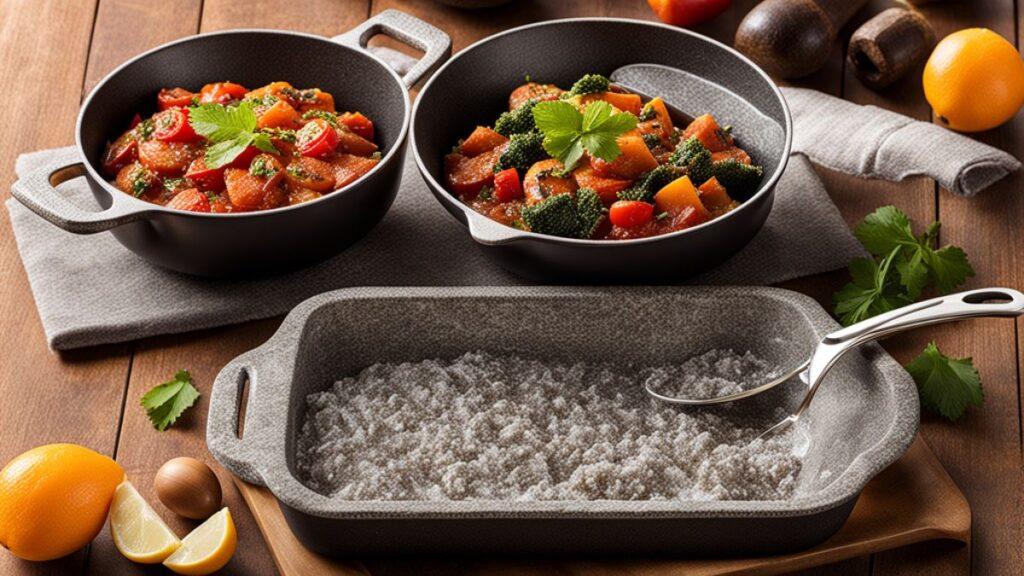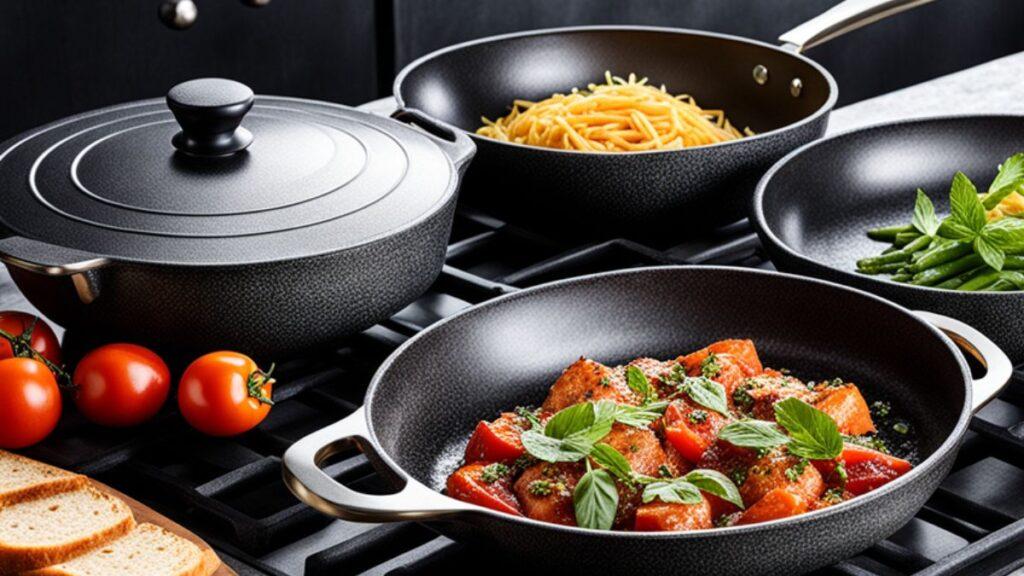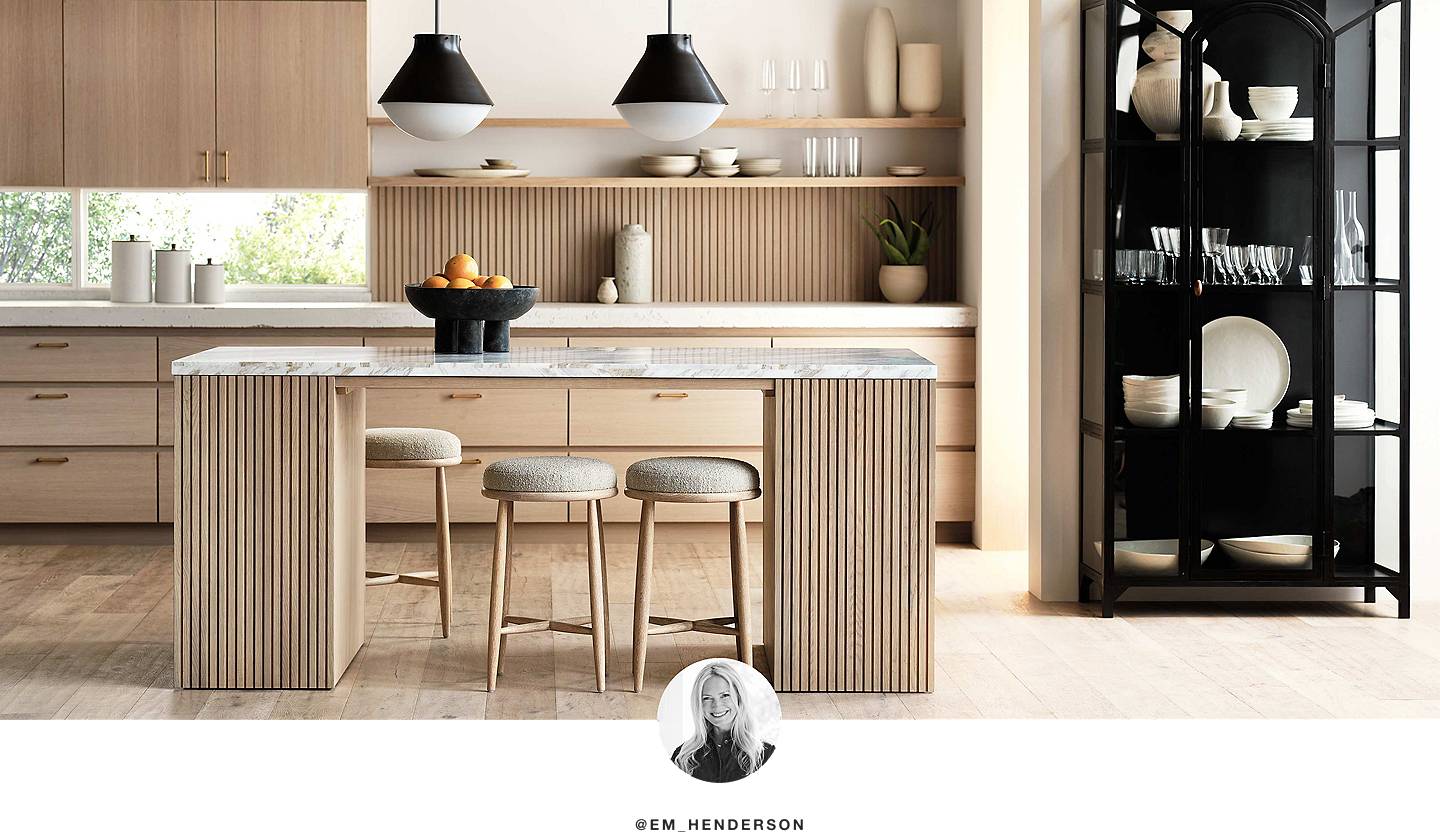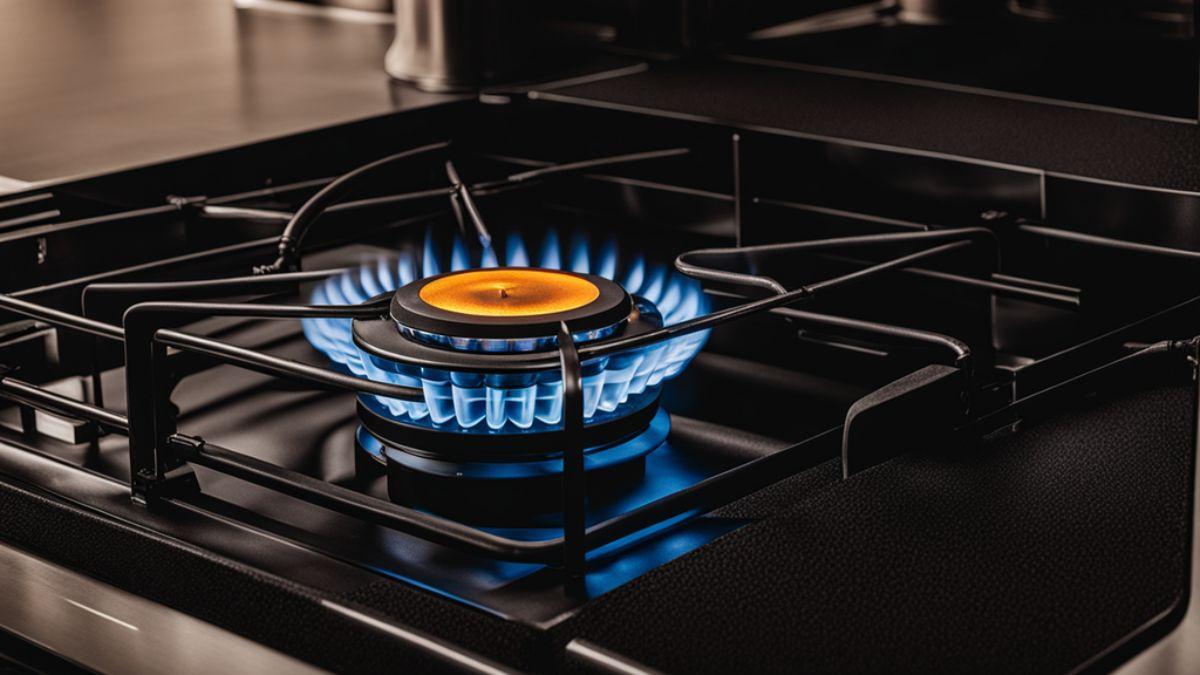
We may earn money or products from the companies mentioned in this post.
Stone cookware offers durability and even heat distribution, but can be heavy and require careful maintenance. It is less likely to have toxic coatings compared to other non-stick options.
Stone cookware is increasingly popular among those seeking a healthier and eco-friendly option for their culinary adventures. It provides a stellar non-stick surface without the need for synthetic coatings that may raise health concerns. Its superior heat retention translates into evenly cooked meals, enhancing flavor and texture.
Yet, users must be ready to handle its weight and adhere to specific care instructions to preserve its functionality. Ideal for home chefs committed to sustainable cooking practices, stone cookware balances performance with environmental consciousness, all while promising a safe and enjoyable cooking experience.
Read More: Curtis Stone Cookware Reviews: Is It Worth Buying in 2024?
Introduction To Stone Cookware

Stone cookware brings ancient traditions to modern kitchens. This type of cookware offers natural non-stick properties. It promises a blend of durability and healthy cooking. Home cooks and professionals are turning to stone cookware. The cookware’s appeal lies in its eco-friendly components and timeless design.
Origins And Resurgence In Modern Kitchens
Stone cookware’s roots trace back to older civilizations. People cooked on natural hot stones. Today’s stone cookware is revolutionizing kitchen practices with its unique attributes. The resilience and capacity to withstand high temperatures resembles the enduring spirit of ancient cooking techniques.
Main Components And Materials Used
Modern stone cookware consists of key materials. These include a base of metallic alloy and a coating of crushed stone.
- Base materials of iron, aluminum, or stainless steel offer even heating.
- Top coatings feature granite, diamond, or marble dust mixed into a non-stick compound.
Manufacturers finely craft these elements to create premium cookware.
Read More: La Sera Stainless Steel Cookware: Unleash Culinary Magic!
Benefits Of Cooking With Stone

Imagine cooking with materials from the heart of nature. Stone cookware brings durability, efficiency, and health to your kitchen. Let’s explore how this ancient cooking companion can transform your culinary experience.
Enhanced Durability And Longevity
Stone cookware stands the test of time. Robust and resistant to wear, these pieces often outlive their metal or plastic counterparts. Unlike other materials, stone resists chipping, scratching, and general degradation. This means less replacement over time—an investment in your kitchen’s future.
Non-stick Qualities And Healthier Cooking
Stone surfaces naturally prevent food from sticking. This reduces the need for excessive oil, slashing the fat content in your meals. Less oil equals healthier dishes. Cleaning also becomes a breeze, as food particles glide off during washing. Enjoy guilt-free cooking with minimal clean-up.
Even Heat Distribution
Hot spots in pans can ruin a meal. Stone cookware is known for uniform heat distribution. This ensures that your food cooks evenly, providing a consistent taste and texture. Say goodbye to partially uncooked foods—with stone, every bite is cooked to perfection.
Downsides To Consider
Exploring the world of stone cookware reveals numerous benefits. Yet, it’s essential to weigh in some downsides. Taking a closer look helps make an informed decision before investing in this particular kitchen gear.
Potential Heaviness And Handling Difficulties
Stone cookware stands out for its durability. Yet, this comes with a notable heft. The weight can be a drawback for those with limited arm strength or for quick maneuvering during cooking. Handling the cookware often requires more effort. It also means extra care when storing, as heavy pots and pans can strain shelves and cabinets.
Risk Of Breakage And Care Instructions
While known for robustness, stone cookware isn’t immune to cracking. Accidental drops or thermal shock can lead to breakage. To prevent damage, follow care instructions closely. Avoid sudden temperature changes. Always gradually preheat the cookware. Remember to hand wash only, as dishwashers may prove too harsh for stone surfaces.
Price Comparison With Other Cookware Options
| Type of Cookware | Price Range |
|---|---|
| Stone Cookware | $50 – $200 |
| Non-Stick Teflon | $20 – $100 |
| Stainless Steel | $30 – $500 |
| Cast Iron | $20 – $200 |
When compared to alternatives, stone cookware often appears pricier. Quality pieces can significantly dent the budget. Brands vary in cost, with some premium options reflected in higher price tags. Shoppers need to balance their willingness to spend against the cookware’s long-term value.
Read More: Can Induction Base Cookware Be Used on Gas Stoves? Myth-Busting Facts!

Credit: www.architecturaldigest.com
Safety And Health Implications
Safety and health implications are at the forefront when choosing cookware. Stone cookware offers benefits and potential drawbacks you should consider. Let’s explore the safety aspects of these products.
Chemical Leaching Concerns
One major concern with any cookware is chemical leaching. This is when cookware materials mix into food. Stone cookware has a reputation for being safer, as it often lacks harmful chemicals like PFOA and PFAS, found in non-stick pans. However, quality matters. Low-quality stone cookware could still pose risks. Always look for certifications guaranteeing no harmful chemicals are used.
Temperature Tolerance And Thermal Shock
Stone cookware is known for even heat distribution. But it’s essential to understand its limits. Sudden temperature changes can lead to thermal shock, causing cookware to crack or shatter. Always allow stone cookware to warm up gradually and avoid moving it from one extreme temperature to another quickly. High-quality stone cookware typically withstands higher temperatures but always check the manufacturer’s instructions.
| Stone Cookware Type | Max Temperature |
|---|---|
| High-Quality Stone Cookware | 500°F |
| Regular Stone Cookware | 350°F – 400°F |
- Check temperature ratings before use.
- Gradually heat to prevent cracking.
- Avoid quick temperature shifts.
Read More: La Sera Cookware: Master Elegant Evenings in Style
Making The Right Choice
Choosing the right cookware is crucial for every kitchen. Stone cookware offers unique features. It’s vital to weigh its strengths and weaknesses. This balanced view aids in making an informed decision. So, let’s explore the pros and cons of stone cookware.
Comparing To Other Cookware Types
Stone cookware stands out for its durability and heat distribution. Unlike metal pots and pans, stone resists scratching. But it’s heavier than aluminum and less conductive than copper. Here’s a quick comparison:
- Aluminum: Lightweight, but reacts with acidic foods.
- Stainless Steel: Durable, yet food sticks easily.
- Copper: Great heat conductor, but high maintenance.
- Non-Stick: Easy to clean, but the coating can wear off.
Personal Cooking Needs And Compatibility
Your cooking style is key. Consider what you cook most often. Stone cookware suits slow cooking and even heating. It’s ideal for dishes that need steady temperatures.
| Food Type | Compatibility with Stone |
|---|---|
| Sauces | Good |
| Meats | Excellent |
| Delicate Fish | Not Recommended |
| Quick Stir-fry | Fair |
Maintenance And Long-term Use
Maintaining stone cookware requires care. To preserve its non-stick qualities, avoid metal utensils. Hand washing is better than a dishwasher. With proper care, it lasts years. It’s a commitment worth considering. Here’s a maintenance checklist:
- Use wood or silicone utensils to prevent scratching.
- Hand wash with mild soap.
- Avoid thermal shock by letting it cool before washing.
- Season occasionally if recommended by the manufacturer.

Credit: www.crateandbarrel.com
Real User Experiences
Diving into the world of stone cookware, it’s crucial to understand what real users think. Home cooks have shared their experiences, shedding light on the practicality and performance of these tools in everyday life. Let’s explore authentic feedback from customers and common practices for using stone cookware effectively.
Customer Reviews And Ratings
Stone cookware has garnered attention for its unique features. To give you unbiased insights, we’ve compiled data from various product reviews. Remarkably, a majority of users rave about stone cookware’s non-stick qualities and how it stands up to daily use.
| Aspect | User Rating |
|---|---|
| Durability | 4.5/5 |
| Heat Distribution | 4.7/5 |
| Ease of Cleaning | 4.8/5 |
| Non-Stick Performance | 4.6/5 |
“Cleans like a dream and cooks evenly,” one user states. Another note, “Heavy and sturdy without being too heavy.”
Common Recipes And Best Practices
Stone cookware excels with a variety of recipes. From searing meats to sautéing vegetables, users find it versatile. Below, we list beloved recipes and tips for optimal use.
- Fried Eggs – Slide right off the pan.
- Grilled Cheese – Perfectly golden without extra oil.
- Stir Fry Veggies – Quick and evenly cooked.
To maintain stone cookware, remember these pointers:
- Avoid sharp utensils to maintain the non-stick surface.
- Use low to medium heat for longevity.
- Clean with soft sponges and avoid harsh detergents.
Wrap-up: Is Stone Cookware Right For You?
Deciding on the right cookware involves weighing benefits against drawbacks. Stone cookware is popular for its non-stick properties and durability. In this wrap-up, readers will find summarized key points, helping to make an informed choice.
Summary Of Pros And Cons
| Pros | Cons |
|---|---|
| Heavier: More difficult to handle. Price: Can be more costly.Sensitivity to Temperature: Not shock-proof.Variability: Quality differs among brands.Not Induction Ready: Special coatings needed. | Heavier: More difficult to handle.Price: Can be more costly.Sensitivity to Temperature: Not shock-proof.Variability: Quality differs among brands.Not Induction Ready: Special coatings needed. |
Final Thoughts And Recommendations
Stone cookware has clear advantages. Its non-stick surface and easy-to-clean nature simplify meal preparations. Yet, it’s weighty, and initial costs might be higher. Consider personal cooking habits and kitchen needs. Preference for healthier cooking with less oil and durable pans may lean you towards stone cookware. But if budget and weight are a concern, explore other options. Always check compatibility with your stove type and brand reliability. Stone cookware could be a smart investment for the right kitchen.
Frequently Asked Questions For Stone Cookware Pros And Cons
Is Stone Cookware Safe For Health?
Stone cookware is generally considered safe for health. It’s often free from harmful chemicals like PFOA and PFTE, commonly found in non-stick coatings. Its natural stone-derived coating ensures minimal toxin release during cooking, making it a healthier option for meal preparation.
How Does Stone Cookware Affect Cooking?
Stone cookware offers even heat distribution, reducing hot spots and preventing food from burning. It retains heat well, keeping food warm longer. However, it may take longer to heat up compared to metal cookware and may require seasoning to enhance its non-stick properties.
Can Stone Cookware Go In The Oven?
Many stone cookware pieces are oven-safe, often withstanding temperatures up to 500°F. However, it’s essential to check the manufacturer’s guidelines for the specific temperature limit and if the handles are also oven-proof to avoid damage.
What Is The Durability Of Stone Cookware?
Stone cookware, when maintained properly, is remarkably durable. It resists scratching and chipping better than traditional non-stick surfaces. Avoiding metal utensils and harsh cleaning supplies can prolong its life. However, its lifespan may be shorter than cast iron or stainless steel options.
Conclusion
Deciding on the right cookware is key to mastering your kitchen skills. Stone options offer durability and a non-toxic surface while keeping in mind their weight and initial cost. This balance of benefits and drawbacks should guide your choice. Picking stone means investing in long-term, health-conscious cooking.
Let your culinary needs and preferences lead!






